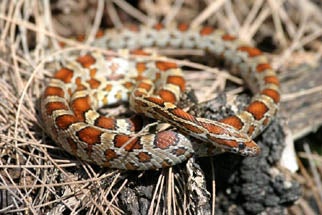SCIENTIFIC NAME:
Pantherophis guttatus
STATUS:
Uncommon to locally fairly common statewide. While still fairly common in northern Alabama, Coastal Plain populations have declined precipitously. MODERATE CONSERVATION CONCERN.
DESCRIPTION:
A medium-sized to rather large snake attaining a maximum length of about 72 inches. Corn snakes have black-bordered red or dark orange blotches that run down the middle of the back, on a reddish orange or brownish orange background color. Two alternating rows of smaller blotches run along each side, extending into the belly scales. Belly is white and conspicuously marked with large boxlike black splotches becoming stripes under the tail. The top of the head usually has two convergent stripes that form a “spear-point” directed anteriorly.
Geographic variation in color is pronounced in Alabama Corn Snakes. Individuals from the Lower Coastal Plain have vivid orange and red markings while those from the northernmost provinces are darker and less vividly marked. Variations between the two areas appear to be gradual. Corn snakes are one of the most colorful snakes in our range. The name Corn Snake probably originated from the similarity of the belly marking to the checkered patterns of kernels on Indian corn.
DISTRIBUTION:
Statewide – Uncommon to locally fairly common throughout. Coastal Plain populations have declined sharply.
HABITAT:
Found in wooded groves, rocky hillsides, meadowlands, around springs, woodlots, barnyards and abandoned houses. Occurs in greatest abundance around abandoned farms and other places where small rodents are likely to thrive. Somewhat arboreal, but less so than related rat snakes. Corn snakes nest in loose soil or organic debris and are commonly found under fallen logs.
FEEDING HABITS:
Adults mainly feed on mice, but will also eat birds, eggs, insects, rats, bats and other small mammals. Juveniles feed mainly on lizards and small frogs.
LIFE HISTORY AND ECOLOGY:
Primarily nocturnal, but often active at dawn and early evening. Corn snakes mate from March to May and lay 3 to 21 eggs from May to July. Average clutch size is ten and the eggs hatch in about 8 to 10 weeks. Hatchlings are 10 to 15 inches long and mature in 18 to 36 months. Life span is 21 to 22 years in captivity.
References:
Mount, Robert H. 1975. The Reptiles and Amphibians of Alabama. Auburn Printing Company, Alabama. 347 pp.
Knopf, Alfred A. 1979. The Audubon Society Field Guide to North American Reptiles and Amphibians. Chanticleer Press, Inc. New York. 743 pp.
Mirarchi, Ralph E. 2004. Alabama Wildlife, Volume One. The University of Alabama Press, Alabama. 209 pp.
Author:
Marisa Futral, Wildlife Biologist, Division of Wildlife and Freshwater Fisheries






